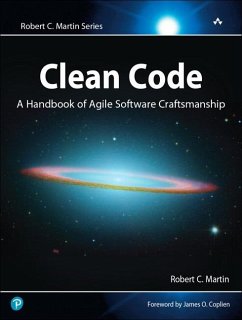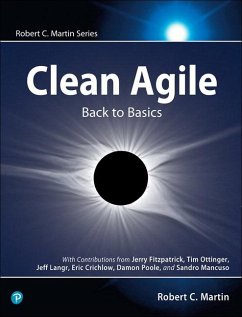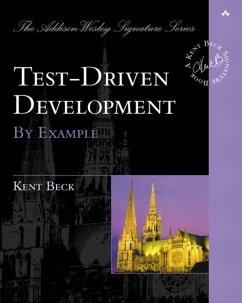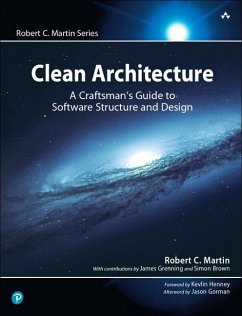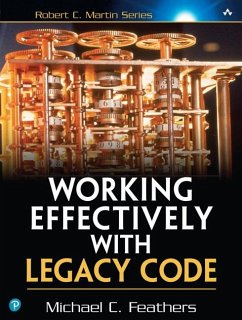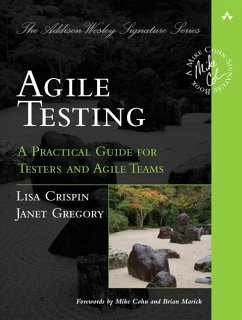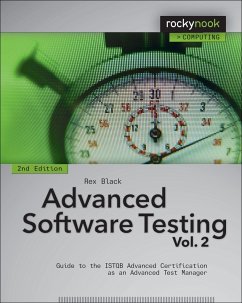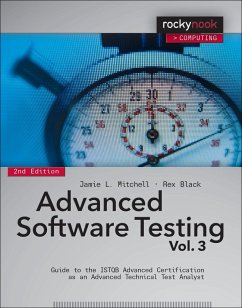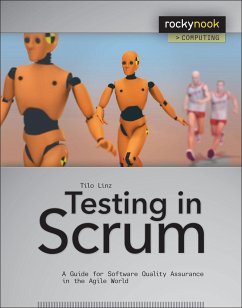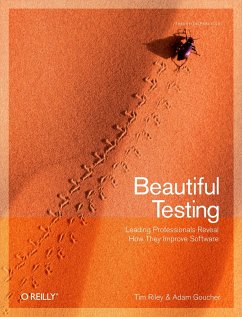
Fit for Developing Software
Framework for Integrated Tests
Versandkostenfrei!
Versandfertig in über 4 Wochen
59,99 €
inkl. MwSt.

PAYBACK Punkte
30 °P sammeln!
Testing was once regarded as a separate and unique discipline within the overallsoftware development process. The reality today is that a growing number ofprojects are spreading the responsibility of testing among more members of theteam. In other words, testing is no longer limited to testers. This new bookintroduces Fit: a proven, effective, and powerful open source framework forautomating the software testing process. Fit (Framework for IntegratedTesting) is vendor-independent and widely praised for its practicality. Eachteaching point of Fit is backed up by supremely useful examples, and RickMugridge and Ward Cunningham (the founder of Fit) offer advice on how tomake Fit digestible to all members of a development team. The result is a costefficientframework that will allow organizations to deliver better software in amore timely fashion.
Product Description
The unique thing about Fit for Developing Software is the way it addresses the interface between customers/testers/analysts and programmers. All will find something in the book about how others wish to be effectively communicated with. A Fit book for programmers wouldn't make sense because the goal is to create a language for business-oriented team members. A Fit book just for businesspeople wouldn't make sense because the programmers have to be involved in creating that language. The result is a book that should appeal to a wide range of people whose shared goal is improving team communications.
--Kent Beck, Three Rivers Institute
Even with the best approaches, there always seemed to be a gap between the software that was written and the software the user wanted. With Fit we can finally close the loop. This is an important piece in the agile development puzzle.
--Dave Thomas, coauthor of The Pragmatic Programmer
Ward and Rick do a great job in eschewing the typical, overly complicated technology trap by presenting a simple, user-oriented, and very usable technology that holds fast to the agile principles needed for success in this new millennium.
--Andy Hunt, coauthor of The Pragmatic Programmer
Florida Tech requires software engineering students to take a course in programmer testing, which I teach. Mugridge and Cunningham have written a useful and instructive book, which will become one of our course texts.
--Cem Kaner, Professor of Software Engineering, Florida Institute of Technology
Rick and Ward continue to amaze me. Testing business rules is a fundamentally hard thing that has confounded many, and yet these two have devised a mechanism that cuts to the essence of the problem. In this work they offer a simple, thorough, approachable, and automatable means of specifying and testing such rules.
--Grady Booch, IBM Fellow
By providing a simple, effective method for creating and automating tabular examples of requirements, Fit has dramatically improved how domain experts, analysts, testers, and programmers collaborate to produce quality software.
--Joshua Kerievsky, founder, Industrial Logic, Inc., and author of Refactoring to Patterns
Agile software development relies on collaborating teams, teams of customers, analysts, designers, developers, testers, and technical writers. But, how do they work together? Fit is one answer, an answer that has been thoroughly thought through, implemented, and tested in a number of situations. Primavera has significantly stabilized its product lineusing Fit, and I'm so impressed by the results that I'm suggesting it to everyone I know. Rick and Ward, in their everlasting low-key approach, have again put the keystone in the arch of software development. Congratulations and thanks from the software development community.
--Ken Schwaber, Scrum Alliance, Agile Alliance, and codeveloper of Scrum
Fit is the most important new technique for understanding and communicating requirements. It's a revolutionary approach to bringing experts and programmers together. This book describes Fit comprehensively and authoritatively. If you want to produce great software, you need to read this book.
--James Shore, Principal, Titanium I.T. LLC
There are both noisy and quiet aspects of the agile movement and it is often the quieter ones that have great strategic importance. This book by Ward and Rick describes one of these absolutely vital, but often quieter, practices--testing business requirements. A renewed focus on testing, from test-driven development for developers to story testing for customers, is one of the agile community's great contributions to our industry, and this book will become one of the cornerstones of that contribution. Stories are done-done (ready for release) when they have been tested by both developers (done) and customers (done-done). The concepts and practices involved in customer story testing are critical to project success and wonderfully portrayed in this book. Buy it. Read it. Keep it handy in your day-to-day work.
--Jim Highsmith, Director of Agile Software Development & Project Management Practice, Cutter Consortium
I have been influenced by many books, but very few have fundamentally changed how I think and work. This is one of those books. The ideas in this book describe not just how to use a specific framework in order to test our software, but also how we should communicate about and document that software. This book is an excellent guide to a tool and approach that will fundamentally improve how you think about and build software--as it has done for me.
--Mike Cohn, Mountain Goat Software, author of User Stories Applied
Fit is a tool to help whole teams grow a common language for describing and testing the behavior of software. This books fills a critical gap--helping both product owners and programmers learn what Fit is and how to use it well.
--Bill Wake, independent consultant
Over the past several years, I've been using Fit and FitNesse with development teams. They are not only free and powerful testing tools, they transform development by making the behavior of applications concrete, verifiable, and easily observable. The only thing that has been missing is a good tutorial and reference. Rick Mugridge and Ward Cunningham's Fit For Developing Software fits the bill. Essentially, two books in one, it is a very readable guide that approaches Fit from technical and nontechnical perspectives. This book is a significant milestone and it will make higher software quality achievable for many teams.
--Michael C. Feathers, author of Working Effectively with Legacy Code, and consultant, Object Mentor, Inc.
Wow! This is the book I wish I had on my desk when I did my first story test-driven development project. It explains the philosophy behind the Fit framework and a process for using it to interact with the customers to help define the requirements of the project. It makes Fit so easy and approachable that I wrote my first FitNesse tests before I even I finished the book.
For the price of one book, you get two, written by the acknowledged thought leaders of Fit testing. The first is written for the nonprogramming customer. It lays out how you can define the functionality of the system you are building (or modifying) using tabular data. It introduces a range of different kinds of 'test fixtures' that interpret the data and exercise the system under test. While it is aimed at a nontechnical audience, even programmers will find it useful because it also describes the process for interacting with the customers, using the Fit tests as the focal point of the interaction.
The second 'book' is targeted to programmers. It describes how to build each kind of fixture described in the first book. It also describes many other things that need to be considered to have robust automated tests--things like testing without a database to make tests run faster. A lot of the principles will be familiar to programmers who have used any member of the xUnit family of unit testing frameworks. Rick and Ward show you how to put it into practice in a very easy-to-read narrative style that uses a fictitious case study to lead you through all the practices and decisions you are likely to encounter.
--Gerard Meszaros, ClearStream Consulting
The Fit open source testing framework brings unprecedented agility to the entire development process. Fit for Developing Software shows you how to use Fit to clarify business rules, express them with concrete examples, and organize the examples into test tables that drive testing throughout the software lifecycle. Using a realistic case study, Rick Mugridge and Ward Cu Backcover
The unique thing about Fit for Developing Software is the way it addresses the interface between customers/testers/analysts and programmers. All will find something in the book about how others wish to be effectively communicated with. A Fit book for programmers wouldn't make sense because the goal is to create a language for business-oriented team members. A Fit book just for businesspeople wouldn't make sense because the programmers have to be involved in creating that language. The result is a book that should appeal to a wide range of people whose shared goal is improving team communications.
--Kent Beck, Three Rivers Institute
Even with the best approaches, there always seemed to be a gap between the software that was written and the software the user wanted. With Fit we can finally close the loop. This is an important piece in the agile development puzzle.
--Dave Thomas, coauthor of The Pragmatic Programmer
Ward and Rick do a great job in eschewing the typical, overly complicated technology trap by presenting a simple, user-oriented, and very usable technology that holds fast to the agile principles needed for success in this new millennium.
--Andy Hunt, coauthor of The Pragmatic Programmer
Florida Tech requires software engineering students to take a course in programmer testing, which I teach. Mugridge and Cunningham have written a useful and instructive book, which will become one of our course texts.
--Cem Kaner, Professor of Software Engineering, Florida Institute of Technology
Rick and Ward continue to amaze me. Testing business rules is a fundamentally hard thing that has confounded many, and yet these two have devised a mechanism that cuts to the essence of the problem. In this work they offer a simple, thorough, approachable, and automatable means of specifying and testing such rules.
--Grady Booch, IBM Fellow
By providing a simple, effective method for creating and automating tabular examples of requirements, Fit has dramatically improved how domain experts, analysts, testers, and programmers collaborate to produce quality software.
--Joshua Kerievsky, founder, Industrial Logic, Inc., and author of Refactoring to Patterns
Agile software development relies on collaborating teams, teams of customers, analysts, designers, developers, testers, and technical writers. But, how do they work together? Fit is one answer, an answer that has been thoroughly thought through, implemented, and tested in a number of situations. Primavera has significantly stabilized its product lineusing Fit, and I'm so impressed by the results that I'm suggesting it to everyone I know. Rick and Ward, in their everlasting low-key approach, have again put the keystone in the arch of software development. Congratulations and thanks from the software development community.
--Ken Schwaber, Scrum Alliance, Agile Alliance, and codeveloper of Scrum
Fit is the most important new technique for understanding and communicating requirements. It's a revolutionary approach to bringing experts and programmers together. This book describes Fit comprehensively and authoritatively. If you want to produce great software, you need to read this book.
--James Shore, Principal, Titanium I.T. LLC
There are both noisy and quiet aspects of the agile movement and it is often the quieter ones that have great strategic importance. This book by Ward and Rick describes one of these absolutely vital, but often quieter, practices--testing business requirements. A renewed focus on testing, from test-driven development for developers to story testing for customers, is one of the agile community's great contributions to our industry, and this book will become one of the cornerstones of that contribution. Stories are done-done (ready for release) when they have been tested by both developers (done) and customers (done-done). The concepts and practices involved in customer story testing are critical to project success and wonderfully portrayed in this book. Buy it. Read it. Keep it handy in your day-to-day work.
--Jim Highsmith, Director of Agile Software Development & Project Management Practice, Cutter Consortium
I have been influenced by many books, but very few have fundamentally changed how I think and work. This is one of those books. The ideas in this book describe not just how to use a specific framework in order to test our software, but also how we should communicate about and document that software. This book is an excellent guide to a tool and approach that will fundamentally improve how you think about and build software--as it has done for me.
--Mike Cohn, Mountain Goat Software, author of User Stories Applied
Fit is a tool to help whole teams grow a common language for describing and testing the behavior of software. This books fills a critical gap--helping both product owners and programmers learn what Fit is and how to use it well.
--Bill Wake, independent consultant
Over the past several years, I've been using Fit and FitNesse with development teams. They are not only free and powerful testing tools, they transform development by making the behavior of applications concrete, verifiable, and easily observable. The only thing that has been missing is a good tutorial and reference. Rick Mugridge and Ward Cunningham's Fit For Developing Software fits the bill. Essentially, two books in one, it is a very readable guide that approaches Fit from technical and nontechnical perspectives. This book is a significant milestone and it will make higher software quality achievable for many teams.
--Michael C. Feathers, author of Working Effectively with Legacy Code, and consultant, Object Mentor, Inc.
Wow! This is the book I wish I had on my desk when I did my first story test-driven development project. It explains the philosophy behind the Fit framework and a process for using it to interact with the customers to help define the requirements of the project. It makes Fit so easy and approachable that I wrote my first FitNesse tests before I even I finished the book.
For the price of one book, you get two, written by the acknowledged thought leaders of Fit testing. The first is written for the nonprogramming customer. It lays out how you can define the functionality of the system you are building (or modifying) using tabular data. It introduces a range of different kinds of 'test fixtures' that interpret the data and exercise the system under test. While it is aimed at a nontechnical audience, even programmers will find it useful because it also describes the process for interacting with the customers, using the Fit tests as the focal point of the interaction.
The second 'book' is targeted to programmers. It describes how to build each kind of fixture described in the first book. It also describes many other things that need to be considered to have robust automated tests--things like testing without a database to make tests run faster. A lot of the principles will be familiar to programmers who have used any member of the xUnit family of unit testing frameworks. Rick and Ward show you how to put it into practice in a very easy-to-read narrative style that uses a fictitious case study to lead you through all the practices and decisions you are likely to encounter.
--Gerard Meszaros, ClearStream Consulting
The Fit open source testing framework brings unprecedented agility to the entire development process. Fit for Developing Software shows you how to use Fit to clarify business rules, express them with concrete examples, and organize the examples into test tables that drive testing throughout the software lifecycle. Using a realistic case study, Rick Mugridge and Ward Cu Foreword.
Preface.
Acknowledgments.
About the Authors.
1. Introduction.
The Need for Fit
The Value of Fit Tables
Fit and Business Roles
Organization of the Book
The Book's Use of Color
I. INTRODUCING FIT TABLES.
2. Communicating with Tables.
Fit Tables
Tables for Communicating
Tables for Testing
Tables, Fixtures, and a System Under Test
Reading Fit Tables
3. Testing Calculations with ColumnFixture Tables.
Calculating Discount
Reports: Traffic Lights
Calculating Credit
Selecting a Phone Number
Summary
Exercises
4. Testing Business Processes with ActionFixture Tables.
Buying Items
Actions on a Chat Server
Summary
Exercises
5. Testing Lists with RowFixture Tables.
Testing Lists Whose Order Is Unimportant
Testing Lists Whose Order Is Important
Summary
Exercises
6. Testing with Sequences of Tables.
Chat Room Changes
Discount Group Changes
Summary
Exercises
7. Creating Tables and Running Fit.
Using Spreadsheets for Tests
Organizing Tests in Test Suites
Using HTML for Tests
Summary
Exercises
8. Using FitNesse.
Introduction
Getting Started
Organizing Tests with Subwikis
Test Suites
Ranges of Values
Other Features
Summary
Exercises
9. Expecting Errors.
Expected Errors with Calculations
Expected Errors with Actions
Summary
10. FitLibrary Tables.
Flow-Style Actions with DoFixture
Expected Errors with DoFixture
Actions on Domain Objects with DoFixture
Setup
CalculateFixture Tables
Ordered List Tables
Testing Parts of a List
Summary
Exercises
11. A Variety of Tables.
Business Forms
Testing Associations
Two-Dimensional Images
Summary
Exercises
II. DEVELOPING TABLES FOR RENTAPARTYSOFTWARE.
12. Introducing Fit at RentAPartySoftware.
RentAPartySoftware
Development Issues
An Initial Plan
The Cast
The Rest of This Part
Summary
Exercises
13. Getting Started: Emily and Don's First Table.
Introduction
Choosing Where to Start
The Business Rule
Starting Simple
Adding the Grace Period
Adding High-Demand Items
Reports
Seth's Return
Summary
Exercises
14. Testing a Business Process: Cash Rentals.
Introduction
Cash Rentals
Split and Restructure
Which Client
Summary
Exercises
15. Tests Involving the Date and Time.
Introduction
Charging a Deposit
Dates
Business Transactions
Sad Paths
Reports
Summary
Exercises
16. Transforming Workflow Tests into Calculation Tests.
Introduction
Testing Calculations Instead
Using Durations
Reports
Summary
Exercises
17. Story Test-Driven Development with Fit.
Introduction
The Stories
The First Storytests
The Planning Game
Adding to the Storytests
Progress During the Iteration
Exploratory Testing at Iteration End
Summary
Exercises
18. Designing and Refactoring Tests to Communicate Ideas.
Principles of Test Design
Fit Tests for Business Rules
Workflow Tests
Calculation Tests
List Tests
Tests and Change
Automation of Tests
Summary
19. Closing for Nonprogrammers.
The Value of Fit Tables
Getting Fit at RentAPartySoftware
III. INTRODUCING FIT FIXTURES.
20. Connecting Tables and Applications.
Writing Fixtures
Fixtures and Traffic Lights
21. Column Fixtures.
Fixture CalculateDiscount
Extending Credit
Selecting a Phone Number
ColumnFixture in General
Summary
Exercises
22. Action Fixtures.
Buying Items
Changing State of Chat Room
ActionFixture in General
Summary
Exercises
23. List Fixtures.
Testing Unordered Lists
Testing Ordered Lists
Testing a List with Parameters
Summary
Exercises
24. Fixtures for Sequences of Tables.
Chat Room Fixtures
Discount Group Fixtures
Summary
Exercises
25. Using Other Values in Tables.
Standard Values
Values of Money
Values in FitNesse and the Flow Fixtures
Summary
Exercises
26. Installing and Running Fit.
Installing Fit and FitLibrary
Running Fit on Folders
Running Fit on HTML Files
Running Tests During the Build
Other Ways to Run Tests
Summary
27. Installing FitNesse.
Installation
Locating the Code
Larger-Scale Use with
Product Description
The unique thing about Fit for Developing Software is the way it addresses the interface between customers/testers/analysts and programmers. All will find something in the book about how others wish to be effectively communicated with. A Fit book for programmers wouldn't make sense because the goal is to create a language for business-oriented team members. A Fit book just for businesspeople wouldn't make sense because the programmers have to be involved in creating that language. The result is a book that should appeal to a wide range of people whose shared goal is improving team communications.
--Kent Beck, Three Rivers Institute
Even with the best approaches, there always seemed to be a gap between the software that was written and the software the user wanted. With Fit we can finally close the loop. This is an important piece in the agile development puzzle.
--Dave Thomas, coauthor of The Pragmatic Programmer
Ward and Rick do a great job in eschewing the typical, overly complicated technology trap by presenting a simple, user-oriented, and very usable technology that holds fast to the agile principles needed for success in this new millennium.
--Andy Hunt, coauthor of The Pragmatic Programmer
Florida Tech requires software engineering students to take a course in programmer testing, which I teach. Mugridge and Cunningham have written a useful and instructive book, which will become one of our course texts.
--Cem Kaner, Professor of Software Engineering, Florida Institute of Technology
Rick and Ward continue to amaze me. Testing business rules is a fundamentally hard thing that has confounded many, and yet these two have devised a mechanism that cuts to the essence of the problem. In this work they offer a simple, thorough, approachable, and automatable means of specifying and testing such rules.
--Grady Booch, IBM Fellow
By providing a simple, effective method for creating and automating tabular examples of requirements, Fit has dramatically improved how domain experts, analysts, testers, and programmers collaborate to produce quality software.
--Joshua Kerievsky, founder, Industrial Logic, Inc., and author of Refactoring to Patterns
Agile software development relies on collaborating teams, teams of customers, analysts, designers, developers, testers, and technical writers. But, how do they work together? Fit is one answer, an answer that has been thoroughly thought through, implemented, and tested in a number of situations. Primavera has significantly stabilized its product lineusing Fit, and I'm so impressed by the results that I'm suggesting it to everyone I know. Rick and Ward, in their everlasting low-key approach, have again put the keystone in the arch of software development. Congratulations and thanks from the software development community.
--Ken Schwaber, Scrum Alliance, Agile Alliance, and codeveloper of Scrum
Fit is the most important new technique for understanding and communicating requirements. It's a revolutionary approach to bringing experts and programmers together. This book describes Fit comprehensively and authoritatively. If you want to produce great software, you need to read this book.
--James Shore, Principal, Titanium I.T. LLC
There are both noisy and quiet aspects of the agile movement and it is often the quieter ones that have great strategic importance. This book by Ward and Rick describes one of these absolutely vital, but often quieter, practices--testing business requirements. A renewed focus on testing, from test-driven development for developers to story testing for customers, is one of the agile community's great contributions to our industry, and this book will become one of the cornerstones of that contribution. Stories are done-done (ready for release) when they have been tested by both developers (done) and customers (done-done). The concepts and practices involved in customer story testing are critical to project success and wonderfully portrayed in this book. Buy it. Read it. Keep it handy in your day-to-day work.
--Jim Highsmith, Director of Agile Software Development & Project Management Practice, Cutter Consortium
I have been influenced by many books, but very few have fundamentally changed how I think and work. This is one of those books. The ideas in this book describe not just how to use a specific framework in order to test our software, but also how we should communicate about and document that software. This book is an excellent guide to a tool and approach that will fundamentally improve how you think about and build software--as it has done for me.
--Mike Cohn, Mountain Goat Software, author of User Stories Applied
Fit is a tool to help whole teams grow a common language for describing and testing the behavior of software. This books fills a critical gap--helping both product owners and programmers learn what Fit is and how to use it well.
--Bill Wake, independent consultant
Over the past several years, I've been using Fit and FitNesse with development teams. They are not only free and powerful testing tools, they transform development by making the behavior of applications concrete, verifiable, and easily observable. The only thing that has been missing is a good tutorial and reference. Rick Mugridge and Ward Cunningham's Fit For Developing Software fits the bill. Essentially, two books in one, it is a very readable guide that approaches Fit from technical and nontechnical perspectives. This book is a significant milestone and it will make higher software quality achievable for many teams.
--Michael C. Feathers, author of Working Effectively with Legacy Code, and consultant, Object Mentor, Inc.
Wow! This is the book I wish I had on my desk when I did my first story test-driven development project. It explains the philosophy behind the Fit framework and a process for using it to interact with the customers to help define the requirements of the project. It makes Fit so easy and approachable that I wrote my first FitNesse tests before I even I finished the book.
For the price of one book, you get two, written by the acknowledged thought leaders of Fit testing. The first is written for the nonprogramming customer. It lays out how you can define the functionality of the system you are building (or modifying) using tabular data. It introduces a range of different kinds of 'test fixtures' that interpret the data and exercise the system under test. While it is aimed at a nontechnical audience, even programmers will find it useful because it also describes the process for interacting with the customers, using the Fit tests as the focal point of the interaction.
The second 'book' is targeted to programmers. It describes how to build each kind of fixture described in the first book. It also describes many other things that need to be considered to have robust automated tests--things like testing without a database to make tests run faster. A lot of the principles will be familiar to programmers who have used any member of the xUnit family of unit testing frameworks. Rick and Ward show you how to put it into practice in a very easy-to-read narrative style that uses a fictitious case study to lead you through all the practices and decisions you are likely to encounter.
--Gerard Meszaros, ClearStream Consulting
The Fit open source testing framework brings unprecedented agility to the entire development process. Fit for Developing Software shows you how to use Fit to clarify business rules, express them with concrete examples, and organize the examples into test tables that drive testing throughout the software lifecycle. Using a realistic case study, Rick Mugridge and Ward Cu Backcover
The unique thing about Fit for Developing Software is the way it addresses the interface between customers/testers/analysts and programmers. All will find something in the book about how others wish to be effectively communicated with. A Fit book for programmers wouldn't make sense because the goal is to create a language for business-oriented team members. A Fit book just for businesspeople wouldn't make sense because the programmers have to be involved in creating that language. The result is a book that should appeal to a wide range of people whose shared goal is improving team communications.
--Kent Beck, Three Rivers Institute
Even with the best approaches, there always seemed to be a gap between the software that was written and the software the user wanted. With Fit we can finally close the loop. This is an important piece in the agile development puzzle.
--Dave Thomas, coauthor of The Pragmatic Programmer
Ward and Rick do a great job in eschewing the typical, overly complicated technology trap by presenting a simple, user-oriented, and very usable technology that holds fast to the agile principles needed for success in this new millennium.
--Andy Hunt, coauthor of The Pragmatic Programmer
Florida Tech requires software engineering students to take a course in programmer testing, which I teach. Mugridge and Cunningham have written a useful and instructive book, which will become one of our course texts.
--Cem Kaner, Professor of Software Engineering, Florida Institute of Technology
Rick and Ward continue to amaze me. Testing business rules is a fundamentally hard thing that has confounded many, and yet these two have devised a mechanism that cuts to the essence of the problem. In this work they offer a simple, thorough, approachable, and automatable means of specifying and testing such rules.
--Grady Booch, IBM Fellow
By providing a simple, effective method for creating and automating tabular examples of requirements, Fit has dramatically improved how domain experts, analysts, testers, and programmers collaborate to produce quality software.
--Joshua Kerievsky, founder, Industrial Logic, Inc., and author of Refactoring to Patterns
Agile software development relies on collaborating teams, teams of customers, analysts, designers, developers, testers, and technical writers. But, how do they work together? Fit is one answer, an answer that has been thoroughly thought through, implemented, and tested in a number of situations. Primavera has significantly stabilized its product lineusing Fit, and I'm so impressed by the results that I'm suggesting it to everyone I know. Rick and Ward, in their everlasting low-key approach, have again put the keystone in the arch of software development. Congratulations and thanks from the software development community.
--Ken Schwaber, Scrum Alliance, Agile Alliance, and codeveloper of Scrum
Fit is the most important new technique for understanding and communicating requirements. It's a revolutionary approach to bringing experts and programmers together. This book describes Fit comprehensively and authoritatively. If you want to produce great software, you need to read this book.
--James Shore, Principal, Titanium I.T. LLC
There are both noisy and quiet aspects of the agile movement and it is often the quieter ones that have great strategic importance. This book by Ward and Rick describes one of these absolutely vital, but often quieter, practices--testing business requirements. A renewed focus on testing, from test-driven development for developers to story testing for customers, is one of the agile community's great contributions to our industry, and this book will become one of the cornerstones of that contribution. Stories are done-done (ready for release) when they have been tested by both developers (done) and customers (done-done). The concepts and practices involved in customer story testing are critical to project success and wonderfully portrayed in this book. Buy it. Read it. Keep it handy in your day-to-day work.
--Jim Highsmith, Director of Agile Software Development & Project Management Practice, Cutter Consortium
I have been influenced by many books, but very few have fundamentally changed how I think and work. This is one of those books. The ideas in this book describe not just how to use a specific framework in order to test our software, but also how we should communicate about and document that software. This book is an excellent guide to a tool and approach that will fundamentally improve how you think about and build software--as it has done for me.
--Mike Cohn, Mountain Goat Software, author of User Stories Applied
Fit is a tool to help whole teams grow a common language for describing and testing the behavior of software. This books fills a critical gap--helping both product owners and programmers learn what Fit is and how to use it well.
--Bill Wake, independent consultant
Over the past several years, I've been using Fit and FitNesse with development teams. They are not only free and powerful testing tools, they transform development by making the behavior of applications concrete, verifiable, and easily observable. The only thing that has been missing is a good tutorial and reference. Rick Mugridge and Ward Cunningham's Fit For Developing Software fits the bill. Essentially, two books in one, it is a very readable guide that approaches Fit from technical and nontechnical perspectives. This book is a significant milestone and it will make higher software quality achievable for many teams.
--Michael C. Feathers, author of Working Effectively with Legacy Code, and consultant, Object Mentor, Inc.
Wow! This is the book I wish I had on my desk when I did my first story test-driven development project. It explains the philosophy behind the Fit framework and a process for using it to interact with the customers to help define the requirements of the project. It makes Fit so easy and approachable that I wrote my first FitNesse tests before I even I finished the book.
For the price of one book, you get two, written by the acknowledged thought leaders of Fit testing. The first is written for the nonprogramming customer. It lays out how you can define the functionality of the system you are building (or modifying) using tabular data. It introduces a range of different kinds of 'test fixtures' that interpret the data and exercise the system under test. While it is aimed at a nontechnical audience, even programmers will find it useful because it also describes the process for interacting with the customers, using the Fit tests as the focal point of the interaction.
The second 'book' is targeted to programmers. It describes how to build each kind of fixture described in the first book. It also describes many other things that need to be considered to have robust automated tests--things like testing without a database to make tests run faster. A lot of the principles will be familiar to programmers who have used any member of the xUnit family of unit testing frameworks. Rick and Ward show you how to put it into practice in a very easy-to-read narrative style that uses a fictitious case study to lead you through all the practices and decisions you are likely to encounter.
--Gerard Meszaros, ClearStream Consulting
The Fit open source testing framework brings unprecedented agility to the entire development process. Fit for Developing Software shows you how to use Fit to clarify business rules, express them with concrete examples, and organize the examples into test tables that drive testing throughout the software lifecycle. Using a realistic case study, Rick Mugridge and Ward Cu Foreword.
Preface.
Acknowledgments.
About the Authors.
1. Introduction.
The Need for Fit
The Value of Fit Tables
Fit and Business Roles
Organization of the Book
The Book's Use of Color
I. INTRODUCING FIT TABLES.
2. Communicating with Tables.
Fit Tables
Tables for Communicating
Tables for Testing
Tables, Fixtures, and a System Under Test
Reading Fit Tables
3. Testing Calculations with ColumnFixture Tables.
Calculating Discount
Reports: Traffic Lights
Calculating Credit
Selecting a Phone Number
Summary
Exercises
4. Testing Business Processes with ActionFixture Tables.
Buying Items
Actions on a Chat Server
Summary
Exercises
5. Testing Lists with RowFixture Tables.
Testing Lists Whose Order Is Unimportant
Testing Lists Whose Order Is Important
Summary
Exercises
6. Testing with Sequences of Tables.
Chat Room Changes
Discount Group Changes
Summary
Exercises
7. Creating Tables and Running Fit.
Using Spreadsheets for Tests
Organizing Tests in Test Suites
Using HTML for Tests
Summary
Exercises
8. Using FitNesse.
Introduction
Getting Started
Organizing Tests with Subwikis
Test Suites
Ranges of Values
Other Features
Summary
Exercises
9. Expecting Errors.
Expected Errors with Calculations
Expected Errors with Actions
Summary
10. FitLibrary Tables.
Flow-Style Actions with DoFixture
Expected Errors with DoFixture
Actions on Domain Objects with DoFixture
Setup
CalculateFixture Tables
Ordered List Tables
Testing Parts of a List
Summary
Exercises
11. A Variety of Tables.
Business Forms
Testing Associations
Two-Dimensional Images
Summary
Exercises
II. DEVELOPING TABLES FOR RENTAPARTYSOFTWARE.
12. Introducing Fit at RentAPartySoftware.
RentAPartySoftware
Development Issues
An Initial Plan
The Cast
The Rest of This Part
Summary
Exercises
13. Getting Started: Emily and Don's First Table.
Introduction
Choosing Where to Start
The Business Rule
Starting Simple
Adding the Grace Period
Adding High-Demand Items
Reports
Seth's Return
Summary
Exercises
14. Testing a Business Process: Cash Rentals.
Introduction
Cash Rentals
Split and Restructure
Which Client
Summary
Exercises
15. Tests Involving the Date and Time.
Introduction
Charging a Deposit
Dates
Business Transactions
Sad Paths
Reports
Summary
Exercises
16. Transforming Workflow Tests into Calculation Tests.
Introduction
Testing Calculations Instead
Using Durations
Reports
Summary
Exercises
17. Story Test-Driven Development with Fit.
Introduction
The Stories
The First Storytests
The Planning Game
Adding to the Storytests
Progress During the Iteration
Exploratory Testing at Iteration End
Summary
Exercises
18. Designing and Refactoring Tests to Communicate Ideas.
Principles of Test Design
Fit Tests for Business Rules
Workflow Tests
Calculation Tests
List Tests
Tests and Change
Automation of Tests
Summary
19. Closing for Nonprogrammers.
The Value of Fit Tables
Getting Fit at RentAPartySoftware
III. INTRODUCING FIT FIXTURES.
20. Connecting Tables and Applications.
Writing Fixtures
Fixtures and Traffic Lights
21. Column Fixtures.
Fixture CalculateDiscount
Extending Credit
Selecting a Phone Number
ColumnFixture in General
Summary
Exercises
22. Action Fixtures.
Buying Items
Changing State of Chat Room
ActionFixture in General
Summary
Exercises
23. List Fixtures.
Testing Unordered Lists
Testing Ordered Lists
Testing a List with Parameters
Summary
Exercises
24. Fixtures for Sequences of Tables.
Chat Room Fixtures
Discount Group Fixtures
Summary
Exercises
25. Using Other Values in Tables.
Standard Values
Values of Money
Values in FitNesse and the Flow Fixtures
Summary
Exercises
26. Installing and Running Fit.
Installing Fit and FitLibrary
Running Fit on Folders
Running Fit on HTML Files
Running Tests During the Build
Other Ways to Run Tests
Summary
27. Installing FitNesse.
Installation
Locating the Code
Larger-Scale Use with
Testing was once regarded as a separate and unique discipline within the overallsoftware development process. The reality today is that a growing number ofprojects are spreading the responsibility of testing among more members of theteam. In other words, testing is no longer limited to testers. This new bookintroduces Fit: a proven, effective, and powerful open source framework forautomating the software testing process. Fit (Framework for IntegratedTesting) is vendor-independent and widely praised for its practicality. Eachteaching point of Fit is backed up by supremely useful examples, and RickMugridge and Ward Cunningham (the founder of Fit) offer advice on how tomake Fit digestible to all members of a development team. The result is a costefficientframework that will allow organizations to deliver better software in amore timely fashion.



